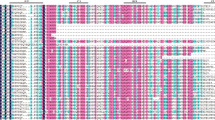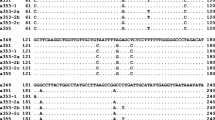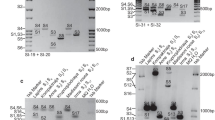Abstract
Sexual self-incompatibility in European pear (Pyrus communis L.) is controlled by a single locus (S-locus) encoding a polymorphic stylar ribonuclease (S-RNase) that is responsible for the female function in pollen–pistil recognition. In this study, genomic DNA sequences corresponding to five new S-RNase alleles (named S 20 , S 21 , S 22 , S 23 , and S 24 ) and to S m were characterized in European pear cultivars. Re-sequencing S q from ‘General Le Clerc’ showed this S-RNase to encode the same protein as S 12 . Based on these findings, a polymerase chain reaction (PCR)-based method was developed for the molecular typing of cultivars bearing 20 S-RNases (S 1 –S 14 , S m , and S 20 –S 24 ) using consensus and allele-specific primers. Genomic PCR with consensus primers amplified product sizes characteristic of the S-RNases S 1 , S 2 , S 4 , S 10 , S 13 , and S 20 . However, the allele groups S 3 /S 12 , S 6 /S 8 /S 11 /S 22 and S 5 /S 7 /S 9 /S 14 /S m /S 21 /S 23 /S 24 amplified PCR products of similar size. To discriminate between alleles within these groups, primers to specifically amplify each S-RNase were developed. Application of this approach in 19 cultivars with published S-alleles allowed re-evaluation of one of the alleles of ‘Passe Crassane,’ ‘Conference,’ and ‘Condo.’ Finally, this method was used to assign S-genotypes to 37 cultivars. Test crosses confirmed molecular results.



Similar content being viewed by others
Abbreviations
- HVR:
-
hyper-variable region
- S-RNase:
-
self-incompatibility ribonuclease
References
Broothaerts W (2003) New findings in apple S-genotype analysis resolve previous confusion and request the re-numbering of some S-alleles. Theor Appl Genet 106:703–714
Broothaerts W, Janssens GA, Proost P, Broekaert F (1995) cDNA cloning and molecular analysis of two self-incompatibility alleles from apple. Plant Mol Biol 27:499–511
Chung IK, Lee SY, Ito T, Tanaka H, Nam HG, Takagi M (1995) The 5′ flanking sequences of two S alleles in Lycopersicon peruvianum are highly heterologous but contain short blocks of homologous sequences. Plant Cell Physiol 36:1621–1627
Coleman CE, Kao T (1992) The flanking regions of two Petunia inflata S alleles are heterogeneous and contain repetitive sequences. Plant Mol Biol 18:725–737
Crane MB, Lewis D (1942) Genetical studies in pears III. Incompatibility and sterility. J Genet 43:31–44
de Nettancourt D (1977) Incompatibility in angiosperms. In: Frankel R, Gall GAE, Linskens HF (eds) Monographs in theoretical and applied genetics, vol 3. Springer, Berlin Heidelberg New York
Hormaza JI, Dollo L, Polito, VS (1994) Identification of a RAPD marker linked to sex determination in Pistacia vera using bulked segregant analysis. Theor Appl Genet 89:9–13
Ishimizu T, Norioka S, Kanai M, Clarke E, Sakiyama F (1996) Location of cysteine and cystine residues in S-ribonucleases associated with gametophytic self-incompatibility. Eur J Biochem 242:627–635
Ishimizu T, Shinkawa T, Sakiyama F, Norioka S (1998) Primary structural features of rosaceous S-RNases associated with gametophytic self-incompatibility. Plant Mol Biol 37:931–941
Ishimizu T, Inoue K, Shimonaka M, Saito T, Terai O, Norioka S (1999) PCR-based method for identifying the S-genotypes of Japanese pear cultivars. Theor Appl Genet 98:961–967
Janssens GA, Goderis IJ, Broekaert WF, Broothaerts W (1995) A molecular method for S-allele identification in apple based on allele-specific PCR. Theor Appl Genet 91:691–698
Kumar S, Tamura K, Nei M (2004) MEGA3: Integrated software for molecular evolutionary genetics analysis and sequence alignment. Brief Bioinform 5:150–163
Matton DP, Mau S, Okamoto S, Clarke A, Newbigin A (1995) The S-locus of Nicotiana alata: genomic organization and sequence analysis of two S-RNase alleles. Plant Mol Biol 28:847–858
Moriya Y, Yamamoto K, Okada K, Iwanami H, Bessho H, Nakanishi T, Takasaki T (2007) Development of a CAPS marker system for genotyping European pear cultivars harboring 17 S alleles. Plant Cell Rep 26:345–354
Mota M, Tavares L, Oliveira CM (2007) Identification of S-alleles in pear (Pyrus communis L.) cv. ‘Rocha’ and other European cultivars. Scientia Hortic 113:13–19
Ortega E, Boskovic RI, Sargent DJ, Tobutt KR (2006) Analysis of S-RNase alleles of almond (Prunus dulcis): characterization of new sequences, resolution of synonyms and evidence of intragenic recombination. Mol Genet Genomics 276:413–426
Sanzol J (2008) Characterization of length polymorphisms at the 3’ UTR of the Maloideae S-RNase and its application for S-genotyping in European pear. Acta Hort (in press)
Sanzol J, Herrero M (2002) Identification of self-incompatibility alleles in pear (Pyrus communis L.) cultivars. Euphytica 128:325–331
Sanzol J, Robbins TP (2008) Combined analysis of S-alleles in European pear by pollinations and PCR-based S-genotyping; correlation between S-phenotypes and S-RNase genotypes. J Am Soc Hort Sci 133:213–224
Sanzol J, Sutherland BG, Robbins TP (2006) Identification and characterization of genomic DNA sequences of the S-ribonuclease gene associated with self-incompatibility alleles S 1 to S 5 in European pear. Plant Breed 125:513–518
Sassa H, Kakui H, Miyamoto M, Suzuki Y, Hanada T, Ushijima K, Kusaba M, Hirano H, Koba T (2007) S-locus F-Box brothers: multiple and pollen-specific F-Box genes with S-haplotype-specific polymorphisms in apple and Japanese pear. Genetics 175:1869–1881
Sonneveld T, Tobutt KR, Robbins TP (2003) Allele-specific PCR detection of sweet cherry self-incompatibility alleles using consensus and allele-specific primers. Theor Appl Genet 107:1059–1070
Takasaki T, Moriya Y, Okada K, Yamamoto K, Iwanami H, Bessho H, Nakanishi T (2006) cDNA cloning of nine S alleles and establishment of a PCR-RFLP system for genotyping European pear cultivars. Theor Appl Genet 112:1543–1552
Tamura M, Ushijima K, Sassa H, Hirano H, Tao R, Gradziel TM, Dandekar AM (2000) Identification of self-incompatibility genotypes of almond by allele specific PCR analysis. Theor Appl Genet 101:344–349
ten Hoopen R, Harbord RM, Maes T, Nanninga N, Robbins TP (1998) The self-incompatibility (S) locus in Petunia hybrida is located on chromosome III in a region syntenic for the Solanaceae. Plant J 16:729–734
Thompson JD, Gibson TJ, Plewniak F, Jeanmougin F, Higgins DG (1997) The ClustalX windows interface: flexible strategies for multiple sequence alignment aided by quality analysis tools. Nucleic Acids Res 25:4876–4882
Tsukamoto T, Tao R, Iezzoni AF (2008) PCR markers for mutated S-haplotypes enable discrimination between self-incompatible and self-compatible sour cherry selections. Mol Breeding 21:67–80
Vieira CP, Charlesworth D, Vieira J (2003) Evidence for rare recombination at the gametophytic self-incompatibility locus. Heredity 91:262–267
Wang X, Hughes AL, Tsukamoto T, Ando T, Kao T (2001) Evidence that intragenic recombination contributes to allelic diversity of the S-RNase gene at the self-incompatibility (S) locus in Petunia inflata. Plant Physiol 125:1012–1022
Wiersma PA, Wu Z, Zhou L, Hampson C, Kappel F (2001) Identification of new self-incompatibility alleles in sweet cherry (Prunus avium L.) and clarification of incompatibility groups by PCR and sequencing analysis. Theor Appl Genet 102:700–708
Wu HQ, Zhang SL, Qu HQ (2007) Molecular and genetic analyses of S 4 SM RNase allele in Japanese pear ‘Osa-Nijisseiki’ (Pyrus pyrifolia Nakai). Plant Breed 126:77–82
Zisovich AH, Stern RA, Shafir S, Goldway M (2004) Identification of S alleles from the European pear (Pyrus communis L.) and the determination of compatibility among cultivars. J Hortic Sci Biotech 79:101–106
Zuccherelli S, Tassinari P, Broothaerts W, Tartarini S, Dondini L, Sansavini S (2002) S-allele characterization in self-incompatible pear (Pyrus communis L.). Sex Plant Reprod 15:153–158
Acknowledgments
This study was supported by project grants “Consejo Interinstitucional de Ciencia y Tegnología”-AGL2006-13529-C02-02 and “Grupo de Investigación Consolidado” A02-A43. The author is supported by a research contract INIA-CCAA of the “Instituto Nacional de Investigación y Tecnología Agraria y Alimentaria”.
Author information
Authors and Affiliations
Corresponding author
Additional information
Communicated by E. Dirlewanger
Electronic supplementary material
Below is the link to the electronic supplementary material.
ESM S1
(PDF 42.24 KB)
ESM S2
Evaluation of allele-specific primers in cultivars harboring Sn (a) and So (b). PCR amplifications using consensus primers (Con) and allele-specific primers for S 3, S 5, S 6, S 7, S 8, S 9, S 11, S 12, S 14, S m, S 21, S 22, S 23 or S 24. Lanes on the gel are: M: Molecular size marker (Invitrogen), 1: a Seedling offspring of the cultivar ‘Forelle’ (S 1 S n) bearing S n (Sanzol, Lozano and Batlle, unpublished result) and b ‘Leonardeta’ (S 1 S o), 2: ‘Precoce Morettini’ (S 1 S 3), 3: ‘Dr. Jules Gujot’ (S 1 S 5), 4: ‘Beurre Giffard’ (S 1 S 6), 5: ‘El dorado’ (S 1 S 7), 6: ‘Starkrimson’ (S 1 S 8), 7: ‘Delbard Premiere’ (S 1 S 9), 8: ‘Wilder’ (S 1 S 11), 9: ‘Pierre Corneille’ (S 1 S 12), 10: ‘Beurré D’Anjou’ (S 1 S 14), 11: ‘Mondsallard’ (S 4 S m), 12: ‘Passe Crassane’ (S 10 S 21), 13: ‘Cure’ (S 3 S 22), 14: ‘Conselleur de la Court’ (S 3 S 23), 15: ‘Green Summer’ (S 22 S 24). (PDF 119.30 KB)
ESM S3
Pollen tube compatibility following cross and self-pollinations in European pear cultivars. (PDF 23.04 KB)
Rights and permissions
About this article
Cite this article
Sanzol, J. Genomic characterization of self-incompatibility ribonucleases (S-RNases) in European pear cultivars and development of PCR detection for 20 alleles. Tree Genetics & Genomes 5, 393–405 (2009). https://doi.org/10.1007/s11295-008-0194-5
Received:
Revised:
Accepted:
Published:
Issue Date:
DOI: https://doi.org/10.1007/s11295-008-0194-5




